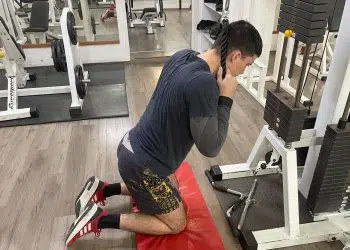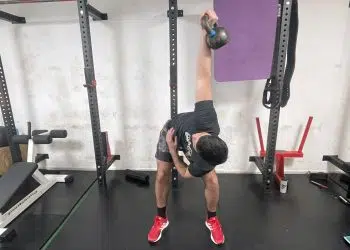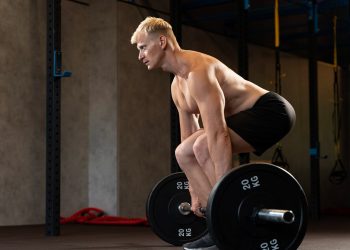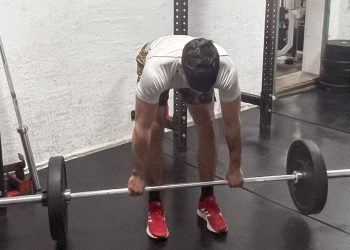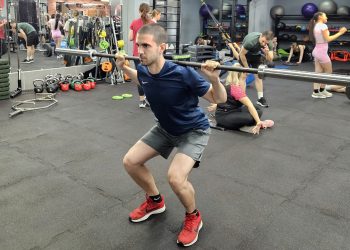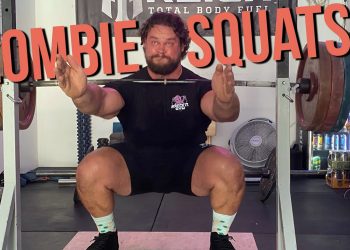Although squats and lunges are crowd favorites for developing buns of steel, they are not the only effective exercises for doing so. Sure, they may build the most muscle and strength, but some isolation movements really do a great job at targeting these muscles solely.
Now, the glutes play a big role in hip abduction, extension, and rotation so naturally, they assist with actions like jumping, running, and heavy lifting. But if we’re talking about visual appeal, then the glutes take the cake. A muscular and toned butt does wonders for physical appearance, and it’s hard to argue anything different.
The standing cable hip extension is an excellent isolation movement for targeting the glute and hamstring muscles. The exercise is performed using a cable machine, which provides resistance through a cable attached to a weight stack.
How To Do Standing Cable Hip Extension
Many people complain about their glutes not firing up while they are exercising. It’s commonly caused due to improper muscle activation. Inactive muscle can also lead to ‘synergistic dominance’, causing the supporting muscle to hijack the movement and eventually enhancing the risk of developing muscle imbalances.
Before we delve into the step-by-step process, preparing for the exercise is essential to improve muscle activation and prevent injuries.
Here are a few tips to help you get the muscle ready for the training:
Level Up Your Fitness: Join our 💪 strong community in Fitness Volt Newsletter. Get daily inspiration, expert-backed workouts, nutrition tips, the latest in strength sports, and the support you need to reach your goals. Subscribe for free!
- Start the workout with 5-10 minutes of light cardio, such as running or jumping jacks. It will help you get the heart rate up and improve the blood flow.
- Dynamic warm-up for the glutes will activate the muscle and get the blood flowing into the target muscle. A few sets of bodyweight glute bridges, clams, and donkey kickbacks will prepare the glutes for the workout.
- Foam rolling is a great way to address muscle stiffness and mobility issues.
Steps:
Let’s get into the step-by-step process to standing cable hip extension.
- Begin by first attaching an ankle strap to the bottom of the cable machine.
- Place your working leg in front and non-working leg back.
- Grab a comfortable place on the machine to stabilize your body.
- Keep an upright posture and make sure your leg stays straight at all times.
- Slowly swing your working leg all the way back until your foot is just beneath the level of your glutes in a controlled manner while squeezing your glutes.
- Then slowly return leg to the starting position but keep it off the ground so you can swing freely.
- Repeat for desired sets and reps.
- Repeat with the opposite leg.
Tips:
Getting the workout done is one thing, and obtaining the most out of it is another. Here are some crucial form tips to help you squeeze the most out of standing hip extension:
- Squeeze your glutes: It is an isolation exercise, and focusing on lengthening and contraction of the gluteus muscle will help you get the most out of it.
- Toe externally rotated: Keeping the toe externally rotated will improve muscle engagement and gets your gluteus medius into action.
- Keep the spine neutral: Many lifters have a tendency of arching their back; this indeed helps you look sexy in the mirror but can be harmful to your spine. Keep your core braced and spine neutral as you perform the exercise.
- Discover the movement pattern: Every individual is built different with distinct body mechanics. Find a movement path that gives you the best mind-muscle connection.
- Maintain constant tension: Make sure that you maintain constant tension in the muscle fibers, do not let the weight plates reach the end of range motion.
- Pre-exhaust: A tip that improves muscle activation before you do the main set. Try a quick, high-rep, low-weight set. It will enhance the quality of muscle contraction and mind-muscle connection.
- Keep resistance moderate and control the movement throughout the entire range of motion. Avoid swinging or using momentum to complete the repetition.
Common Mistakes
Let’s have a look at common mistakes that you must avoid while performing standing cable hip extension:
Using too much weight: This is the most common mistake that novice lifters do all the time. They set too much weight, and then they try to use momentum to complete the set. Using too much weight not only degrades the quality of muscle contraction but also increases the odds of injuries.
Start with the weight that allows you to complete the 10-12 reps with perfect form (without swinging).
Kicking too far back: This leads to the overarching of the back, which transfers the tension from the glutes to the lower back (lumbar area) and increases the chances of injuries.
Tempo: Controlling the tempo will help you get the best mind-muscle connection. Make sure you emphasize enough on the slow eccentric phase.
By avoiding these common mistakes and focusing on proper form and technique, you can maximize the benefits of your glute training and reduce the risk of injury.
Standing Cable Hip Extension: Muscles Worked
Standing sable hip extension is a single joint isolation movement that targets the following muscles:
- Glutes: It is the largest and strongest muscle in the body. The glutes play a crucial role in extending the hips backward, external rotation, and pelvic stabilization.
- Hamstrings: They run down the back of the thigh and play a supporting role in hip extension, especially when the legs are slightly bent.
The degree of all three gluteal muscle activation depends on your form and technique.
Benefits of Standing Cable Hip Extension
The standing cable hip extension is an excellent strength training exercise that targets the glutes and hamstrings. Some of the benefits include:
- Glute isolation: Want to hone in your entire glutes? Standing cable hip extension should be on the top of your list. This exercise targets all three gluteal heads to enhance muscle definition and improve muscle tone.
- Training volume: Isolation exercises are great for accumulating training volume without creating excessive muscle recovery demands from the muscles and joints.
- Better posture: The glutes and hamstrings play a crucial role in maintaining good posture, and strengthening these muscles through the standing cable hip extension can help to improve posture and reduce the risk of lower back pain.
- Unilateral movement: One side is usually stronger than the other. This is the reason unilateral movements play a crucial role in strength training. Standing cable hip extension helps you work on muscle symmetry and correct imbalances by working on a single side at a time.
- Improves hip stability: Glutes medius and minimus not only provide roundness to the glutes but also play an important role in keeping the hip stable and maintaining good pelvic alignment.
- Enhanced athletic performance: Glutes and hamstrings strength dictate athletic performance. Improving the power and speed in activities such as running, jumping, and plyometrics.
- Great for rehab: Standing cable hip extension is categorized as a low-intensity isolation exercise, making it an excellent rehab and prehab exercise for people returning from injuries.
Limitations
Knowing the limitations will help you program the exercise appropriately.
Standing cable hip extension is an isolation exercise and offers a limited capacity to overload. Because of being an isolation exercise, it typically doesn’t provide the same functional benefits as compound exercises. Compound exercises involve engaging multiple muscle groups and joints to work in synergy for enhanced functional strength and reduced risk of injury. In short, you will still need to include some compound movements if you genuinely want to work on the glute strength and functional capability.
Another limitation is the range of motion; standing hip extension offers a pretty limited range of motion compared to its bent-over variation. However, the limited range of motion makes it a very beginner-friendly exercise.
5 Variations of Standing Cable Hip Extension
Learning the variations allows you to upgrade and downgrade the training, as per the requirements. All these variations can be used as a viable standing cable hip extension alternative.
1. Bent-Over Cable Kickback
Bent over standing kickback is an advanced version of standing hip extension that allows a superior range of motion and better glute activation.
As the name suggests, a bent-over standing kickback requires the same setup, with the torso leaned forward to allow a better range of motion. Even though the exercise is called a ‘kickback,’ we want you to think of it as a ‘swing back’ to get the most out of the workout.
Step-by-Step Guide:
- Begin by attaching an ankle strap to the bottom of the cable machine.
- Place your working leg in front and non-working leg back.
- Bend forward from your hips, keeping your back straight and your gaze forward.
- Grab a comfortable place on the machine to support your body.
- Slowly swing your working leg all the way back until your foot is just beneath the level of your glutes in a controlled manner while squeezing your glutes.
- Then slowly return to the starting position but keep it off the ground so you can swing freely.
- Repeat for desired sets and reps.
- Repeat with the opposite leg.
Pro tip: Control the eccentric phase, don’t let the weight fall down as you swing your leg back to starting position.
2. Banded Donkey Kick
Do not have a cable machine available? No problem, a banded donkey kick is an excellent exercise to work on your glutes. It’s a tremendous unilateral exercise for building strength and stability in the glutes and hips.
Level Up Your Fitness: Join our 💪 strong community in Fitness Volt Newsletter. Get daily inspiration, expert-backed workouts, nutrition tips, the latest in strength sports, and the support you need to reach your goals. Subscribe for free!
Banded donkey kick is a beginner-friendly workout that requires just a cushioned mat and a resistance band (booty bands are perfect).
Step-by-Step Guide:
- Place a loop resistance band right above your knees.
- Start in a quadruped position with your hands and knees on a mat. Hands should be placed under your shoulders and your knees under your hips.
- Engage your core and hips in a neutral position.
- Keeping your right knee bent, lift your right leg up and back towards the ceiling, keeping your foot flexed.
- Pause for a moment, then slowly return your leg back down to the start.
- Repeat for the desired reps, then switch to the other leg.
Pro tip: Do not arch your lower back.
3. Single-Leg Glute Bridges
Glute bridge is a great isolation exercise to strengthen the glutes, but performing it with a single leg takes your glute training to a whole new level.
Single-leg glute bridge is an excellent unilateral exercise that allows you to hone in one side at a time — reducing the chances of strength imbalances.
Furthermore, single-leg variation also improves pelvic alignment and hip stability by engaging the gluteus medius and minimus.
Step-by-Step Guide:
- Start by lying on your back with your knees bent and feet flat on the ground.
- Place your hands flat on the ground at your sides for support and lift one leg off the ground.
- Push through your heel to raise your hips until your body forms a straight line from your shoulder to your knee.
- Squeeze your glutes at the top and pause for a second before slowly returning to starting position.
- Repeat for the desired number of reps, then switch to another leg.
Pro tip: Place a dumbbell across your hip crease to increase the resistance.
4. Hip Thrust
The hip thrust is a compound movement that works on the entire posterior chain, including the glutes, hamstrings, lower back, core, and erector spinae.
Sometimes, pure isolation movements are not enough to develop exceptional strength. The hip thrust is a bilateral movement that allows you to overload your muscle with extraordinary weights and strengthen the hip extension, especially for those who suffer from weak glutes.
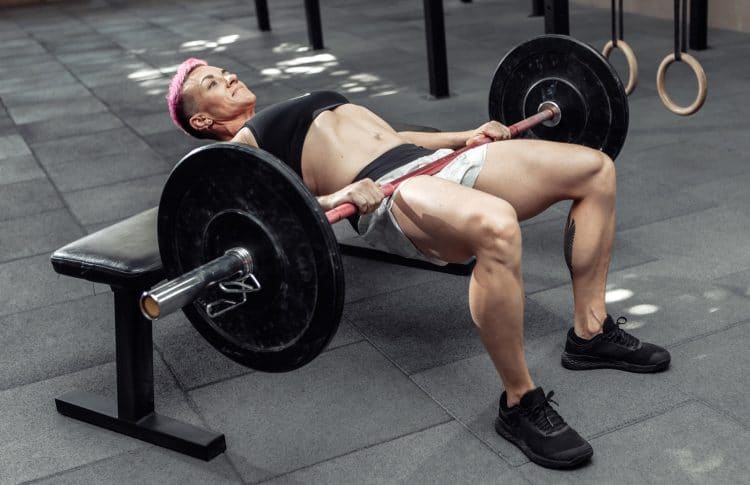
Step-by-Step Guide:
- Start with your back leaning against a bench with your knees bent and feet flat on the ground.
- Place a dumbbell or barbell across your hip crease.
- Push through your heel to raise your hips off the ground until your body forms a straight line from your shoulder to your knee.
- Pause and squeeze your glutes hard at the top.
- Slowly return to the starting position.
- Repeat for the desired number of reps.
Pro tip: It’s essential to start with the light weight and gradually increase the resistance. Control the eccentric phase, and don’t let the weight fall back on the ground.
5. Lateral Step-Ups
Step-ups are wonderful glute builders but primarily focus on the gluteus maximus. On the other hand, lateral step-ups target all three gluteal muscle groups making it a superior alternative.
A study compared the activation of gluteus medius muscles during forward and lateral step-ups. Researchers concluded – lateral step-up exercises require greater gluteus medius activation than forward step-up exercises. [1]
Step-by-Step Guide:
- Grab a dumbbell in each hand and stand next to an elevated surface with your side body facing it.
- Lift the foot closest to the platform and place it on top.
- Using the raised leg, with minimal assistance from the other, push through the whole foot to lift yourself to a standing position on the box.
- Step back down into the starting position.
- Repeat for recommended reps.
- Switch sides and repeat.
Pro tip: Control the negative phase.
Programming Tips
Standing cable hip extension is quite a versatile exercise to add more volume to glutes training. It is a great isolation move that can be paired with compound movement, or utilized as a workout finisher.
If you find it hard to feel your firing up while the big compound moves, then it’s suggested to utilize a standing hip extension and its variation as a glute activation drill.
Sets and Reps
The number of sets and reps should rely on the fitness goal and the training split.
Standing hip extension is a pure isolation movement that should not be performed with heavy weight and low reps (less than ten).
Here is how to decide the sets and reps.
Glutes-only day:
Glutes are a big muscle and definitely deserve a day of their own. Isolation exercises should be followed after the heavy compound moves.
Perform a total of six-eight sets of standing cable hip extension AND its variations. With a rep range between 10-15.
Legs day:
On this day, you need to focus on the quads, hamstrings, glutes, calves, abductors, and adductors. Too many muscles to focus on.
Compound movements like squats and RDLs will hit the most lower body muscle. Perform a total of three-four sets of standing cable hip extension OR its variation. With a rep range between 12-20.
We would rather use it as a workout finisher after doing big compound movements to shape up the glutes and boost the training volume.
Bottom Line
When it comes to building an eye-popping, jaw-dropping butts, many people (especially women) start to pay too much emphasis on the isolation move, leaving substantial gains on the table. Isolation movements like standing cable hip extensions are good for carving out beautiful buns, but they are not entirely capable of building the sheer size and shape. This is why we always suggest our readers to equally emphasize compound movements for improved functional strength and prevent imbalances.
Interested in measuring your progress? Check out our strength standards for Hip Abduction, Hip Extension, Jumping Jack, and more.


